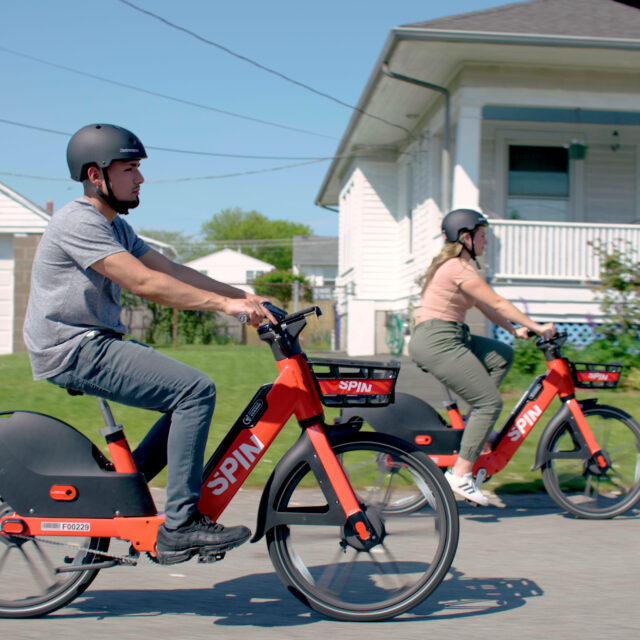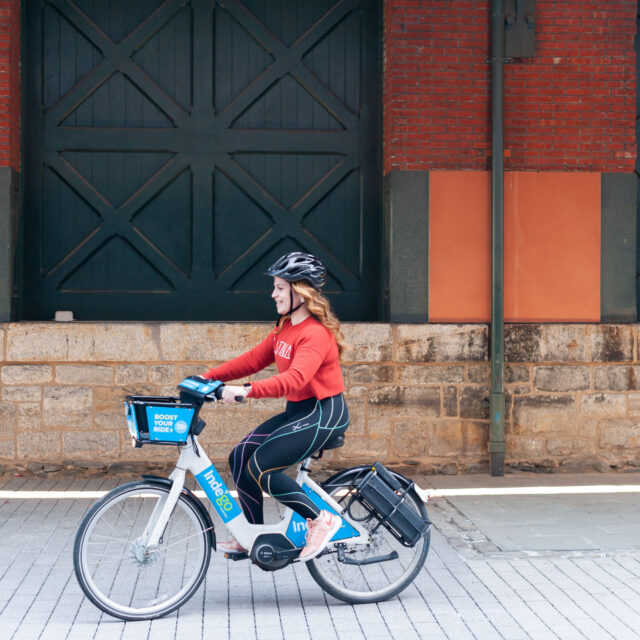2021 Learnings From NABSA
by Kiran Herbert, Communications Manager
November 17, 2021
Here’s what went down at our industry’s annual conference, “Rolling With It: Empowering Shared Micromobility,” and a recent “State of the Industry” roundtable.

On October 28 and 29, the North American Bikeshare & Scootershare Association (NABSA) hosted its annual conference virtually for the second time since the pandemic began. The gathering brought together around 400 shared micromobility and transportation leaders, practitioners, and equipment providers, offering more than 20 sessions plus networking opportunities.
Over the course of two days, attendees tackled important issues currently facing the industry, from COVID-19 to transit integration to the growing role of electrification. Members voted on a new NABSA board, networked during two virtual happy hours, and shared micromobility learnings from across the U.S., Canada, Mexico, and Europe. Everyone celebrated the fact that next year’s conference will be in person, hosted by BKT Bici Pública in Guadalajara, Mexico.
A few weeks later, NABSA and the Shared-Use Mobility Center (SUMC) presented a “State of the Industry” roundtable discussion, which organically built off of conference topics to create a candid conversation around where we are as an industry are and where we’re going next (or where we need to go). What follows are six high-level lessons from both the conference and the roundtable.

1. Teamwork makes the dream work
Panelists across the conference and the roundtable agree: shared micromobility is on the precipice of something big and our actions as an industry will reverberate for generations to come. If that sounds like hyperbole, consider NABSA’s 2021 State of the Industry Report, which highlights the growth of first-time riders and the explosion of e-bikes.
In her opening remarks at the NABSA conference, Caroline Samponaro, head of transit and micromobility policy at Lyft, emphasized the importance of the industry coming together to advance a common agenda and sustain growth. She noted the bike commuter act, public investment in bike share, and the creation of complete streets as key initiatives we should all be fighting for as one unified lobbying bloc. Lyft has calculated that, for every $1 billion invested in bike infrastructure, U.S. citizens could realize 1,500 miles of bike lanes, sidewalks or trails, 5,000 bike share stations, and 10,000 new, green infrastructure jobs.
Of course, shared micromobility is working against decades of car-centric culture and policies, as well as decades of underfunding. However, Horace Dediu, co-founder of Micromobility Industries and an analyst, predicts that the tides are turning, with more and more investors wanting to be on the right side of history. By positioning micromobility as a climate solution that can save us while generating revenue, we’re more likely to secure an influx of both private and public funding.
2. To build a resilient transportation system, we need bikes and scooters
If the last couple of years have shown us anything, it’s that we need different transportation modes to carry us through tough periods. From the pandemic to Hurricane Ida to national Black Lives Matter protests, there were numerous events that made bikes and scooters indispensable in cities across the country. In a world where climate change and societal uncertainty are the “new normal,” shared micromobility can help cities withstand periods of difficulty.
“Bikes and scooters are an essential part of a resilient transportation network,” said Lina Fedirko, transportation program manager at ClimateWorks, noting that the larger presence of transportation issues at COP26—and the small mention of micromobility—gave her hope. Shared micromobility can fill in transit gaps and help everyone, not just commuters, move around easily and effectively.
3. Shared micromobility is the gateway to critical mass
Shared micromobility presents an opportunity for people to try a new mode of transportation and get comfortable riding on city streets. For companies, traditional user acquisition costs are zero, because the product advertises itself. People see others cruising up a hill on an e-bike and decide to give it a try. And since e-bikes allow folks to travel longer distances and replace car trips, many people with the storage space and funds ultimately buy their own. However, some historically underserved groups—people of color, low-income individuals, the elderly, women, differently-abled folk—do require an investment in outreach, education, and ambassadors. To achieve a significant mode shift, resources should be reallocated accordingly.
The bottom line: the more people use shared micromobility, the more cities are likely to invest in safe infrastructure for it, which in turn only facilitates mode shift.
4. Equity work needs to be emphasized and ongoing
The growth of e-bikes is a big equity win, opening up systems to more people (especially the elderly), but it’s not enough on its own. Every micromobility operator needs to be working towards equity, investing in comprehensive community engagement, reforming agencies internally, distributing stations and vehicles equitably, building systems that are inclusive of people with limited mobility, and lobbying for protected infrastructure. Unless we recenter historically underserved populations, we’ll never achieve the kind of mode shift we need.
During the conference, Bicycle Transit Systems chief equity and strategy officer Carniesha Kwashie discussed the ways the operator is working to make its workforce better reflect its user base, building a culture of diversity, equity, inclusion, and justice. Superpedestrian discussed how it incorporates equity into its scooter designs, Spin presented on the work it’s done around bike education, low-income programming, and facilitating infrastructure in underserved communities, and BKT Bici Pública tackled the ways it’s working to achieve gender parity in bike share.
Roundtable participants agreed that equity provisions need to be built into permits and that Black and brown voices need to be centered in advocacy work. What’s more, many pointed to the industry’s marketing as low-hanging fruit that could be easily changed to represent more races, body types, and ways in which our systems are used (a delivery worker commuting, for example).
5. Transit integration is the future
Allowing people to seamlessly connect from a public bus to a shared bike just makes sense: when you only need one phone app to route plan, buy tickets, and ride, you’re more likely to give up your car. Because a one-system model allows for discounts and fair-capping and eliminates barriers for transit users (who tend to be lower-income and/or BIPOC), integration helps make systems more equitable.
In North America, Transit App is driving early adoption amongst operators and transportation agencies and is a key player in Move PGH, a Pittsburgh pilot that pairs low-cost and shared mobility options with the city’s mass transit system. In Europe, Urban Sharing’s whole model is built around helping cities integrate micromobility. And even one of our own Living Lab grantees is focused on integrating bike share and transit in Detroit.
6. More research is needed
There’s been a lot of great research published this year, including studies on the benefits of protected bike lanes for bike share, the impact of bike infrastructure and race on ticketing, the environmental benefits of bike share, and David Rojas’ work on how bike share is a boon for public health. Rojas, a speaker at the NABSA conference, emphasized that for more beneficial research to be conducted, bike share managers and micromobility officials need to collect and publish open access data on the number of standard and electric bikes, the average number of trips per day, substitution mode, type of use, and average trip duration, distance, and speed.
During the industry roundtable, NABSA executive director Sam Herr echoed his sentiments, noting that the industry is currently limited by the data it has. She added that talks about creating a standard user survey are ongoing and crucial; only if we truly understand who’s using shared micromobility and how, can we tailor our work accordingly. Others at the roundtable emphasized the need for more research regarding the sustainability of shared micromobility and its potential impact on carbon emissions, as well as how regulatory measures affect usability.
After all, empirical research demonstrates what we all anecdotally know to be true: shared micromobility is a win-win-win, and it’s not slowing down any time soon.
The Better Bike Share Partnership is funded by The JPB Foundation as a collaboration between the City of Philadelphia, the National Association of City Transportation Officials (NACTO) and the PeopleForBikes Foundation to build equitable and replicable bike share systems. Follow us on Facebook, Twitter and Instagram or sign up for our weekly newsletter. Got a question or a story idea? Email kiran@peopleforbikes.org.



